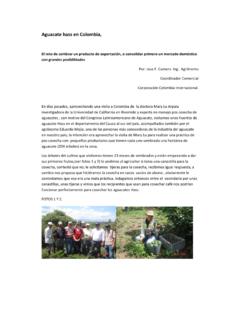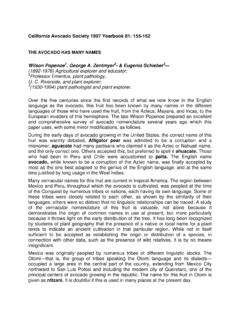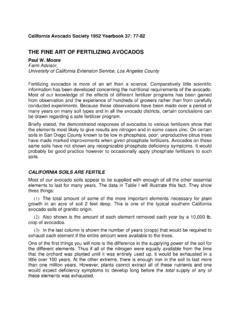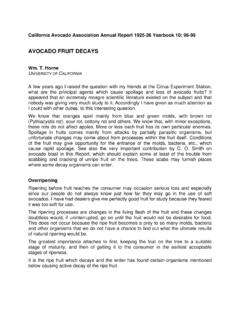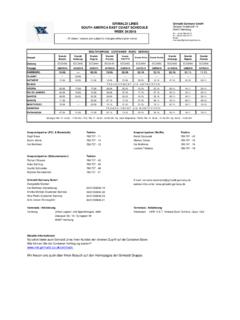Transcription of The Avocado in South Africa
1 California Avocado Society 1965 Yearbook 49: 73-79 THE Avocado IN South Africa Information supplied by the Citrus and Subtropical Fruit Research institute, Nelspruit, South Africa . South Africa , situated between 22 and 34 degrees southern latitude and between 16 and 34 degrees longitude east of Greenwich, has a total surface of approximately 472,000 square miles, , the approximate surface area of California, Florida and Texas combined. Topographically it is largely a highland plateau, with coastal plains along the Indian Ocean in the east and South and along the Atlantic in the west. Its climate ranges from nearly tropical in the northern and eastern lowlands, to subtropical in the higher regions of the provinces of Natal and Transvaal, while the southern portion of the Cape Province has a warm temperate climate.
2 In general the country is rather dry, especially on the high plateau where an annual summer rainfall of about 30 inches in the east diminishes towards the semi-desert regions bordering the Atlantic Ocean in the west. An annual summer rainfall of 30 to 40 inches occurs in the east along the Natal coast, while in the mountainous areas of Natal and Transvaal annual falls of 50 inches and more are not exceptional. The South -western regions of the Cape Province have a winter rainfall and along the southern Indian Ocean coast all-year-round rains prevail. According to the 1960 agricultural census some 230,000 Avocado trees were growing in South Africa , of which approximately 95 per cent were in the Transvaal, 3 per cent in the coastal plains of Natal along the Indian Ocean, and 2 per cent in the lowlands of the Cape Province.
3 Owing to the many trees planted since I960, the present total may be estimated at about 300,000, of which approximately one third are trees under five years of age. Most of the Avocado fruits are sold and consumed locally. On the eight principal municipal markets, which probably handle some 70 per cent of all locally sold fruit, 4,000 tons of avocados with a gross value of about 630,000 dollars were sold during the 1962/1963 season. During that same season 130 tons of avocados were exported by air and at least 150 tons by sea, mainly to England. These figures serve as basis for the following information regarding the South African Avocado industry. The gross revenue from Avocado fruit is approximately 1 million dollars annually. The average annual yield per mature tree is approximately 50 pounds.
4 Records from mature, healthy Fuerte trees under suitable growing conditions indicate an average annual yield of about 120 pounds per tree for this variety in South Africa . The average price of all avocados sold on the municipal markets is about 8 (dollar) cents per pound, or about 6 cents per pound net. Fuerte fruit usually fetches a higher price of about 10 cents, or about 8 cents net, per pound on the local markets. Good Fuerte fruits retail at about 15 cents each in South Africa . Although first planted in the Natal coastal plains, the Avocado has not become an important crop there. Nearly all trees growing in that area are West Indian seedlings; Guatemalan varieties do not flourish under the hot subtropical conditions. Neither West Indian hybrid nor West Indian varieties have been tried there, although some might do well.
5 The large-scale plantings of avocados in the Transvaal commenced in 1938, after imported Californian varieties had been shown to crop well. The plantings are mainly in the mountains of the so-called Transvaal Lowveld, at altitudes ranging approximately from 2,500 to 4,500 feet, on sites selected for freedom from frost. At these higher altitudes temperatures are less extreme and relative air humidities generally higher than in the lower lying areas, while the total annual rainfall, of 40 inches at least, is also higher. The soils used are invariably deep, mainly of granitic origin, with a high water retaining capacity. The main plantings are found in the Nelspruit and Letaba districts and near the town of Louis Trichardt. California varieties are dominant with some scattered seedlings and local varieties.
6 Most of the well known California varieties have been imported, but the majority of them, including the once popular Anaheim, Itzamna and Nabal, are now no longer favoured. Fuerte, on the other hand, is extremely popular and most trees are of this variety. Edranol is at present being planted on a fairly large scale, mainly in the Letaba area. This variety bears well and produces fruit of good quality both for the home and export markets after the Fuerte harvest has been completed. Only Fuerte and, to a smaller extent, Edranol fruit is exported. Varieties still planted on a minor scale are Collinson in practically all areas, for its reliable and heavy bearing, and Ryan, mainly in the warmer areas, for its very late ripening at a time when avocados are scarce. Hass, on the other hand, which has proved to bear well, has not been planted on a large scale, because neither the local nor the English export market favours a dark purple fruit.
7 Carton is the only Mexican variety commercially grown; notwithstanding its dark purple colour this early ripening fruit enjoys a good local demand just before West Indian fruits become available. In the Cape Province, where temperatures are generally lower than in Natal or Transvaal, avocados can be grown only near sea level. Notwithstanding this, the trees do not thrive there, although the proximity of the important markets of Cape Town and East London seems to compensate for this drawback to some extent. The few thousand trees grown in that area are a mixed batch, with Fuerte again the most important variety. In the Transvaal, varieties are propagated by grafting on seedlings grown in 4-gallon containers; the grafted trees are ready for planting in the orchard within 14 months from planting the stock seed.
8 For raising rootstocks, seeds from unselected Mexican seedling trees are used predominantly. Nabal seeds from selected trees, when available, have given very good results. West Indian seeds, on the contrary, have invariably given poor results and Mexican seeds obtained from trees near West Indian trees are often equally disappointing. Planting distances vary greatly, depending on conditions. At present the trend is towards close planting; the space allocated for Fuerte may be about 700 and for Edranol 500 square feet per tree. It is considered that in comparison with the former wider espacements yields per acre are increased, while gaps caused by trees falling prey to root rot are less noticeable. Moreover, weed growth is suppressed, and possibly the decrease in soil temperatures, due to the larger shaded area, is an important factor in the control of root rot.
9 Weeds are usually controlled by hand-hoeing; mechanical cultivation is not favoured, and chemical weed control is not practiced. In the higher, cooler, more humid areas, which usually receive good summer rains and where the trees are growing on deep soils with a high water retaining capacity, irrigation was in the past practiced only sparingly as flood irrigation. Apart from being wasteful of water, it had been shown to increase the danger of the spread of root rot. Recently, however, judicious use of sprinkler irrigation has given very good results and is being increasingly used. For the accurate regulation of water applications tensiometers are being used on the modern estates on an experimental scale; American findings on this subject have been a great help. Fuerte avocados are picked when the percentage of oil is higher than 12 per cent.
10 In the packhouse the fruit is graded according to diameter and further selected according to fruit length to ensure a uniform pack. Counts 12, 14, 16, 18, 29 and 22 are packed in a standard single layer tray having a net weight of ten pounds. For the local markets the fruit is individually wrapped with paper wrappers and packed with sufficient woodwool. For export by air the fruit is similarly packed but in a corrugated carton. For export by sea the standard wooden tray is packed with fruit individually wrapped in synthetic film and precooled to a temperature of 40 degrees F within 24 hours from picking. The subsequent transport of the fruit to the United Kingdom also takes place at this temperature. PROBLEMS The Avocado is a most fastidious tree and unless it finds everything to its liking all sorts of trouble can be expected.
